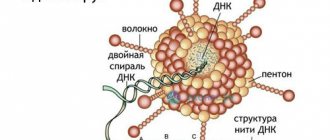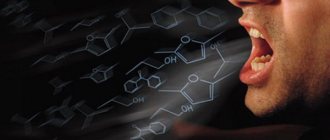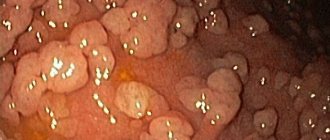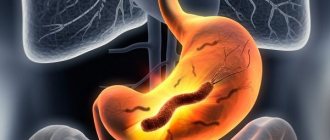Intestinal infections are a large group of infectious diseases of a bacterial and viral nature, occurring with intoxication, intestinal syndrome and dehydration. In the structure of infectious morbidity, intestinal infections occupy second place, second in frequency only to acute respiratory viral infections. They affect children much more often than adults. Intestinal infections are especially dangerous for children in the first years of life.
Source: ogemorroe.com
Causes and risk factors
The causative agents of intestinal infections can be various pathogenic microorganisms - bacteria, protozoa, fungi and viruses. Most often, the development of the disease is caused by:
- gram-negative enterobacteria (Yersinia, Escherichia, Campylobacter, Salmonella, Shigella);
- opportunistic bacteria (staphylococci, proteus, clostridia, klebsiella);
- viruses (adenoviruses, enteroviruses, rotaviruses);
- protozoa (coccidia, amoeba, lamblia);
- mushrooms.
All pathogens of intestinal infections have enteropathogenicity and the ability to synthesize exo- and endotoxins.
The basis for the prevention of intestinal infections is compliance with sanitary and hygienic standards.
The source of infection is patients with a clear or obscured clinical picture of the disease, carriers, and some types of domestic animals. Infection occurs through the fecal-oral mechanism through water, nutritional (through food), contact and household (through household items, toys, dirty hands, dishes) routes.
The cause of the development of intestinal infection caused by opportunistic flora is a sharp weakening of the body's defenses, which can be caused by various reasons. As a result of this, the normal intestinal biocenosis is disrupted, which is accompanied by a decrease in the amount of normal microflora and an increase in opportunistic microflora.
An important role in the development of intestinal infection is played by violations of the rules of preparation and storage of food, and the admission to work in catering units of employees with streptoderma, furunculosis, tonsillitis and other infectious diseases.
Infections transmitted by water and food can affect large groups of the population, causing epidemic outbreaks, but isolated (sporadic) cases are recorded much more often.
The incidence of some types of intestinal infections has a clear seasonal dependence, for example, rotavirus gastroenteritis is more often recorded in the winter months, and dysentery - in the summer.
Factors predisposing to infection are:
- failure to comply with personal hygiene rules;
- low acidity of gastric juice;
- poor sanitary and hygienic living conditions;
- lack of access to quality drinking water;
- intestinal dysbiosis.
Prevention
- wash your hands regularly before eating;
- consume meat and dairy products from proven sources;
- do not drink water from natural reservoirs, do not swim on unofficial beaches;
- wash fruits and vegetables thoroughly, even before heat treatment;
- observe the rules of personal hygiene, do not use other people’s personal belongings (for example, towels);
- If possible, limit contact with people who have signs of intestinal infections.
Read more: Measures to prevent intestinal infections
In continuation of the topic, be sure to read:
- Causes of bloating and increased gas formation, treatment methods
- Rectal fissure: causes, symptoms and treatment of pathology
- The most common infectious bowel diseases
- Irritable bowel syndrome: symptoms and treatments
- Rectal cancer: symptoms, stages, treatment and prognosis for life
- More about hemorrhoids: causes, symptoms and treatment methods
- Details about the coprogram: preparation, conduct and interpretation of the analysis
- Details about bowel cancer: stages, symptoms, treatment and prognosis
- How is rotavirus intestinal infection manifested and treated?
- Yersiniosis: how is intestinal infection manifested and treated?
Be sure to read:
Prolonged diarrhea (a week or more): causes, first aid and treatment
Forms of the disease
Classification of intestinal infection is carried out according to the clinical and etiological principle. The most commonly observed in clinical practice are:
- rotavirus infection;
- dysentery (shigellosis);
- Escherichiosis (coli infection);
- salmonellosis;
- staphylococcal infection.
Depending on the characteristics of the symptoms (intoxication, water-electrolyte imbalance, damage to the gastrointestinal tract), the course of an intestinal infection can be atypical (hypertoxic, erased) or typical (severe, moderate, mild).
Severe dehydration can lead to the development of hypovolemic shock and acute renal failure.
Local manifestations of intestinal infections are determined by which organ of the digestive system is most involved in the pathological process. In this regard, gastritis, gastroenteritis, gastroduodenitis, duodenitis, enteritis, colitis and enterocolitis are distinguished.
In weakened patients, an intestinal infection can spread beyond the gastrointestinal tract and lead to damage to other organs and systems. In this case, they talk about the generalization of the infectious process.
By duration:
- acute intestinal infection - less than 6 weeks;
- prolonged – over 6 weeks;
- chronic – the disease lasts more than 6 months.
general description
Acute intestinal infections are a group of infectious diseases that affect the gastrointestinal tract, which is accompanied by fever and severe intoxication.
Diseases have a number of common nonspecific symptoms, regardless of the cause of the disease. Diseases of this group are a widespread pathology of the gastrointestinal tract in people of any age, but more often in children. Human infection occurs through contaminated dairy and meat products, vegetables, fruits, water and household items. A characteristic feature is tropism and cytotoxicity to the epithelium of the intestinal tract, as well as clinical manifestations of infection in the form of fever, general intoxication and dyspeptic syndrome, the main symptom of which is diarrhea. Specific signs of acute intestinal infection of a general and local nature reflect the virulent properties of a particular pathogen and the state of immunoreactivity of the human body.
According to the etiological principle, they are divided depending on the nature of the pathogen:
- Intestinal infections of bacterial etiology (shigellosis, escherichiosis, salmonellosis, compylobacteriosis, etc.).
- Intestinal infections of viral etiology (rotavirus infection, enterovirus infection, etc.).
- Intestinal infection of protozoal etiology (amoebiasis, cryptosporidiosis, schistosomiasis, etc.).
Symptoms of intestinal infection
Intestinal infection, regardless of the type of pathogen, is manifested by symptoms of intoxication and damage to the gastrointestinal tract. However, some types of the disease have characteristic symptoms.
Dysentery
The incubation period lasts from 1 to 7 days. The disease begins acutely with chills and a rapid rise in temperature to 39-40 °C. At the height of the fever, the patient may experience delirium, disturbances of consciousness, and convulsions. Other symptoms:
- brokenness;
- severe weakness;
- absence or significant decrease in appetite;
- headache;
- myalgia;
- cramping abdominal pain localized in the left iliac region;
- spasm and soreness of the sigmoid colon;
- tenesmus (false urge to defecate);
- signs of sphincteritis;
- defecation from 4 to 20 times per day.
Feces are liquid and contain an admixture of blood and mucus. In severe cases of the infectious process, hemorrhagic syndrome develops, manifested by intestinal bleeding.
The most severe course is characteristic of dysentery caused by Shigella Grigoriev-Shiga or Flexner.
Salmonellosis
In 90% of cases, salmonellosis occurs as gastritis, gastroenteritis or gastroenterocolitis. A subacute onset is typical - the temperature rises to 38-39 ° C, nausea and vomiting occur.
In the acute period of the disease, a water-tea break lasting 1-2 days is prescribed.
In some cases, the liver and spleen become enlarged (hepatosplenomegaly). The stool is frequent and plentiful, the stool takes on the color of swamp mud, and contains minor impurities of blood and mucus. This type of intestinal infection in adults usually ends in recovery, but in children it can become life-threatening due to rapidly developing dehydration.
Source: vancomycin.ru
The respiratory (flu-like) form of Salmonella infection is observed in 4-5% of patients. Its main symptoms:
- febrile temperature;
- headache;
- arthralgia, myalgia;
- conjunctivitis;
- rhinitis;
- pharyngitis;
- arterial hypotension;
- tachycardia.
The typhus-like form of salmonellosis is observed extremely rarely (no more than 2% of all cases). It is characterized by a long period of fever (up to 1–1.5 months), dysfunction of the cardiovascular system and severe general intoxication.
The septic form of salmonellosis is mainly diagnosed in children in the first months of life or in adult patients with severely weakened immunity (HIV infection, severe concomitant diseases). It is extremely difficult. Accompanied by septicopyemia or septicemia, metabolic disorders, and the development of severe complications (parenchymal hepatitis, pneumonia, meningitis, otoanthritis, osteomyelitis).
Escherichiosis
The most extensive group of intestinal infections. It combines coli infections caused by enterohemorrhagic, enteroinvasive, enterotoxigenic and enteropathogenic Escherichia.
The main symptoms of escherichiosis are:
- low-grade or febrile body temperature;
- lethargy, weakness;
- persistent vomiting (in infants - frequent regurgitation);
- decreased appetite;
- flatulence.
The stool is frequent, profuse, watery, yellowish in color. If the disease is caused by enterohemorrhagic Escherichia, then the stool contains an admixture of blood.
The incidence of some types of intestinal infections has a clear seasonal dependence, for example, rotavirus gastroenteritis is more often recorded in the winter months, and dysentery - in the summer.
Repeated vomiting and severe diarrhea quickly lead to dehydration and the development of exicosis. There is dryness of the mucous membranes and skin, the elasticity and turgor of tissues decreases, and the amount of urine discharge decreases.
Rotavirus infection
Rotavirus intestinal infection in most cases occurs as enteritis or gastroenteritis. The average incubation period is 1–3 days. The disease begins acutely, its symptoms reach maximum severity by the end of the first day. One of the main signs of this form is the combination of damage to the gastrointestinal tract with catarrhal symptoms.
Patients experience:
- signs of general intoxication;
- increased body temperature;
- nausea, vomiting;
- diarrhea with a frequency of bowel movements from 4 to 15 times a day (foamy, watery stools);
- respiratory syndrome (sore throat, rhinitis, hyperemia of the pharynx, coughing).
The duration of the disease usually does not exceed 4–7 days.
Staphylococcal intestinal infection
Depending on the mechanism of infection, staphylococcal intestinal infection is of two types:
- primary – the pathogen enters the gastrointestinal tract by water or nutrition from the environment;
- secondary - staphylococci are introduced into the digestive system through the bloodstream from any other foci of primary infection in the body.
Staphylococcal intestinal infection is quite severe and is accompanied by the development of severe toxicosis and exicosis. The stool is watery, frequent, 10–15 times a day. It is greenish in color and may contain a small amount of mucus.
In weakened patients, an intestinal infection can spread beyond the gastrointestinal tract and lead to damage to other organs and systems.
Secondary staphylococcal intestinal infection in adults is extremely rare. Most often it develops in children as a complication of acute tonsillitis, staphyloderma, pneumonia, pyelonephritis and other diseases caused by staphylococci. This form is characterized by a long wave-like flow.
Antibiotics for treatment
There are often cases when it is not possible to call a doctor. We will tell you how to determine which antibiotic for an intestinal infection is right for you and describe what antibacterial drugs exist.
The treatment regimen includes a broad-spectrum antibiotic:
Cephalosporins are bactericidal antibiotics. Trade names: “Cefotaxime”, “Cephabol”, “Rotsesim”, “Claforan”. They are similar in structure to penicillins, but have a side effect - allergies. Tetracyclines are well absorbed from the gastrointestinal tract when taken orally, have a bacteriostatic effect, cause complications (up to deafness), and are contraindicated in children. Trade names: Doxycycline, Vibramycin, Tetradox. Penicillins - "Amoxicillin", "Ampicillin", "Monomycin" and others - have good penetration into the body's cells and selectivity of action, without having a harmful effect on systems and organs; approved for use by children, pregnant and lactating women, side effect - allergic reactions. Aminoglycosides - Gentamicin, Neomycin and others - are used to treat diseases with the spread of microbes in the body, including sepsis, are highly toxic, affect the kidneys, liver, and are permitted for health reasons.
Fluoroquinolones are antibiotics that inhibit the enzyme responsible for DNA synthesis in microbes; prescribed by doctors
Use with caution in people suffering from diseases with vascular lesions; prohibited for children under 18 years of age, pregnant and lactating women. Trade names: “Levofloxacin”, “Ciprolet”, “Norfloxacin”, “Ofloxacin”, “Normax”, “Ciprofloxacin” and others. Macrolides - Roxithromycin, Azithromycin, Erythromycin - have a bacteriostatic effect and are effective against microorganisms
Approved for use by children, pregnant and lactating women, when penicillins are contraindicated due to an allergic reaction. Levomycytin (chloramphenicol), a drug for intestinal infections, has lost its popularity due to side effects, one of which is bone marrow damage.
Most antibiotics are used to treat infectious diseases. Penicillins and aminoglycosides are used to treat ENT organs, laryngitis, tracheitis, bronchitis, pleurisy (presence of fluid in the lungs), etc.
And for intestinal infections, antibiotics from the groups of cephalosporins and fluoroquinolones, sulfonamides are prescribed. Tetracycline is rarely prescribed: mainly only for health reasons.
In the event of an acute infection, an antibacterial drug is prescribed in 100% of cases, in the form of injections. Modern dosages of drugs suggest a course: one injection per day for 7 days. Antibiotics for intestinal infections in adults are all used.
Intestinal antiseptics
They are becoming increasingly popular. These are drugs that destroy pathogenic intestinal flora without affecting the normal flora.
Antiseptics suppress the growth of opportunistic microflora - staphylococcus, Proteus and others. Prescribed in pediatric practice or when there are contraindications to antibacterial drugs:
"Ersefuril" (nifuroxazide) - has no contraindications, is approved for use in children over 6 years of age, suppresses the growth of pathogenic microflora. Microorganisms have not developed resistance to the drug. Effective against dysentery and rotavirus infection. "Furazolidone" is a proven antibacterial drug, effective against pathogens such as Shigella, Salmonella, and other bacteria, and has an immunostimulating effect; “Intetrix” is not only an antimicrobial, but also an antifungal and amoebocidal agent, it causes side effects: nausea and stomach pain, it is used as a prophylactic agent during hikes and travel; "Fthalazol" is a broad-spectrum drug that is active against pathogens
It helps quickly, has a number of side effects, and is prescribed with caution to children. "Enterol" is a live yeast that is an antagonist of pathogenic microorganisms. The drug contains a protease enzyme that destroys endotoxins produced by pathogenic bacteria such as clostridia and E. coli
There are also probiotics that promote the growth of “beneficial” intestinal flora. Additional medications after antibiotics are not needed. The effect is noticeable after taking one capsule. The drug should not be used in combination with antibiotics or adsorbents. Recommended for use by children, pregnant and nursing mothers. Has no contraindications.
Diagnostics
Based on clinical and epidemiological data, the results of a physical examination of the patient, it is possible to diagnose an intestinal infection and, in some cases, even suggest its type. However, establishing the exact etiological cause of the disease is only possible based on the results of laboratory tests.
Bacteriological examination of stool is of greatest diagnostic importance. Material for research should be collected from the first hours of the disease, before the start of therapy with antibacterial drugs. When a generalized form of intestinal infection develops, a bacteriological examination of blood (culture for sterility), urine, and cerebrospinal fluid is performed.
Source: shostka.info
Serological research methods (RSC, ELISA, RPGA) are of certain value in the diagnosis of intestinal infections. They make it possible to detect the presence of antibodies to intestinal pathogens in the blood serum and thus identify them.
To clarify the localization of the pathological process in the gastrointestinal tract, a coprogram is prescribed.
Differential diagnosis is carried out with biliary dyskinesia, lactase deficiency, pancreatitis, acute appendicitis and other pathologies with similar symptoms. If there are indications, the patient is consulted by a surgeon or gastroenterologist.
Local manifestations of intestinal infections are determined by which organ of the digestive system is most involved in the pathological process.
Treatment of intestinal infection
The treatment regimen for intestinal infection includes the following areas:
- oral rehydration;
- therapeutic nutrition;
- pathogenetic therapy - correction of existing dysfunctions of internal organs, increasing immune reactivity and nonspecific resistance of the body, normalizing metabolism;
- etiotropic therapy – elimination of the cause that caused the development of the disease;
- symptomatic therapy – elimination of symptoms of a pathological process.
In order to correct disturbances in water and electrolyte balance, oral rehydration is performed (WHO powder, Regidron, Peditral). Glucose-saline solutions should be drunk often, in small sips - this helps prevent the occurrence or recurrence of vomiting. If the patient’s condition is severe, when he cannot take fluids orally, infusion therapy with solutions of electrolytes and glucose is carried out.
Specific therapy for intestinal infections is carried out with intestinal antiseptics and antibiotics (Nalidixic acid, Furazolidone, Polymyxin, Gentamicin, Kanamycin), enterosorbents (Activated carbon, Filtrum STI, Smecta). If indicated, immunoglobulins (antistaphylococcal, antirotavirus), lactoglobulins and bacteriophages (klebsiella, coliproteus, dysentery, salmonella and others) are prescribed.
Pathogenetic treatment of intestinal infections involves the prescription of antihistamines and enzymes.
For elevated body temperature, non-steroidal anti-inflammatory drugs are indicated. Spasmodic pain in the abdomen is relieved by taking antispasmodics.
In the structure of infectious morbidity, intestinal infections occupy second place, second in frequency only to acute respiratory viral infections.
In the acute period of the disease, a water-tea break lasting 1-2 days is prescribed. The diet of patients with intestinal infections is aimed at improving digestion processes, ensuring mechanical, thermal and chemical sparing of the mucous membrane of the gastrointestinal tract. Food should be taken frequently in small portions. After the acute phenomena have subsided, jelly, weak broths with white crackers, well-cooked rice, mashed potatoes, and steamed meatballs are introduced into the diet.
Causes of intestinal infection
Also through various household items, for example, dishes, toys, dirty hands, door handles, etc. An intestinal infection can be picked up by swimming in various bodies of water. A special place is given to compliance or non-compliance with the most basic hygiene standards.
Symptoms of the disease
Of course, the symptoms will depend on the type of infection, but there are some common ones:
- stomach ache,
- heaviness in the stomach,
- diarrhea and vomiting,
- chills and fever.
Typically, discomfort from an intestinal infection can last up to 2 days; if treatment is not started immediately, you can get dehydrated, since a large amount of fluid leaves the body with vomiting and diarrhea. Do not underestimate the severity of the disease if left untreated, as fatal cases can occur. Therefore, only a doctor, having determined the type of infection, can prescribe the necessary treatment, using traditional medicine.
Traditional medicine recommends
1. A decoction made from calamus root will be very useful. To do this, cook 30 g of crushed roots over low heat for 10 minutes, after straining, drink 0.5 cups up to 6 times a day.
2. Oak bark is also used in the treatment of this disease. Take 40 g of oak bark, steam it in 1 liter of water, then boil for another 10 minutes, filter and also drink like calamus root, up to 6 times a day, 0.5 cups.
3. A good remedy for treating the intestines is marshmallow root. For 10 g of crushed root - 1 liter of water (boiling water). Boil for about 10 minutes (the fire should not be strong), add another 1 g of comfrey and wait 20 minutes, preferably in a warm place, strain and drink 4 glasses per day.
4. There are recipes that can relieve pain in the intestines and calm the stomach, stopping diarrhea. This is a swamp cudweed. You will need 1 tbsp. dried dried fruit, which needs to be steamed with a glass of water (boiling water), left for about 2 hours. Drink 150 ml shortly before meals. This folk remedy is recommended to be used with blue cyanosis, the roots of which are crushed and 1 tbsp. and boil in a glass of water for 30 minutes. Strain the broth and drink 1 tablespoon, preferably after meals, up to 4 times a day, the last dose should be taken before bed.
5. Very effective infusions in the treatment of intestinal infections, which can be brewed in a thermos. For example, cinquefoil, which will need 20 g. It is better to steam in a liter thermos for about an hour. Drink ½ glass at least 3 times a day.
7. Blackberry leaves, like cinquefoil, take 20 g, steam in a thermos, after 30 minutes the infusion will be ready. Drink ½ glass up to 3 times a day.
8. Intestinal infection is successfully treated with St. John's wort. It is not difficult to prepare a decoction; to do this, chop the herb, take 1 tbsp. and steam with a glass of water (boiling water). Afterwards, evaporate again, preferably in a water bath for 30 minutes, strain, and add boiled water to the required volume. The illness will soon recede if you drink 1/3 glass, preferably before meals. Store the broth in the refrigerator for no more than 2 days.
Any infection is treated only with drugs of the appropriate pharmacological group: viral - with antiviral agents, bacterial - with antibiotics. All other medications, including herbal remedies, are symptomatic therapy - they alleviate the patient’s condition without directly affecting the pathogen.
It is worth remembering these simple things in case of intestinal infections. Decoctions and infusions of medicinal herbs will only slightly dull the clinical picture of the pathology, but will not help the body overcome the pathogen. Of course, in combination with antibiotics, folk remedies will have the desired effect, but such therapy should only be prescribed by an infectious disease specialist.
Special drink
Treatment will be incomplete without a special diet for the period of illness and means that help fight dehydration. To do this, dilute 1 tsp in 1 liter of water (the water must be boiled). salt and 8 tsp. Sahara.
Another remedy that helps avoid dehydration is prepared as follows. For 1 liter of boiled water 8 tsp. sugar, ½ tsp. soda, 1 tbsp. orange juice and a little more than a teaspoon of salt.
The advantage of traditional medicine is that, with a correctly formulated recipe and proper use, it minimizes the harmful effects of herbs on the body. But, nevertheless, a number of herbs are either toxic or may cause allergies in some people, so only a doctor can give the necessary recommendation on the use of this or that medicinal composition. Listen to the advice of specialists, and recovery will not take long. Health to everyone!









